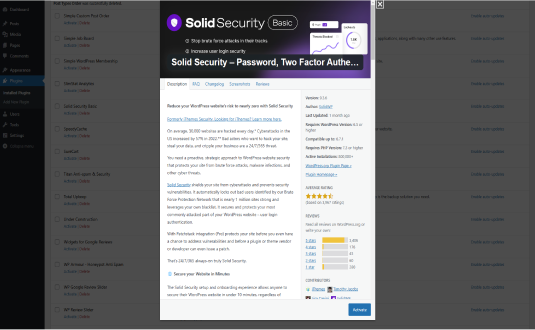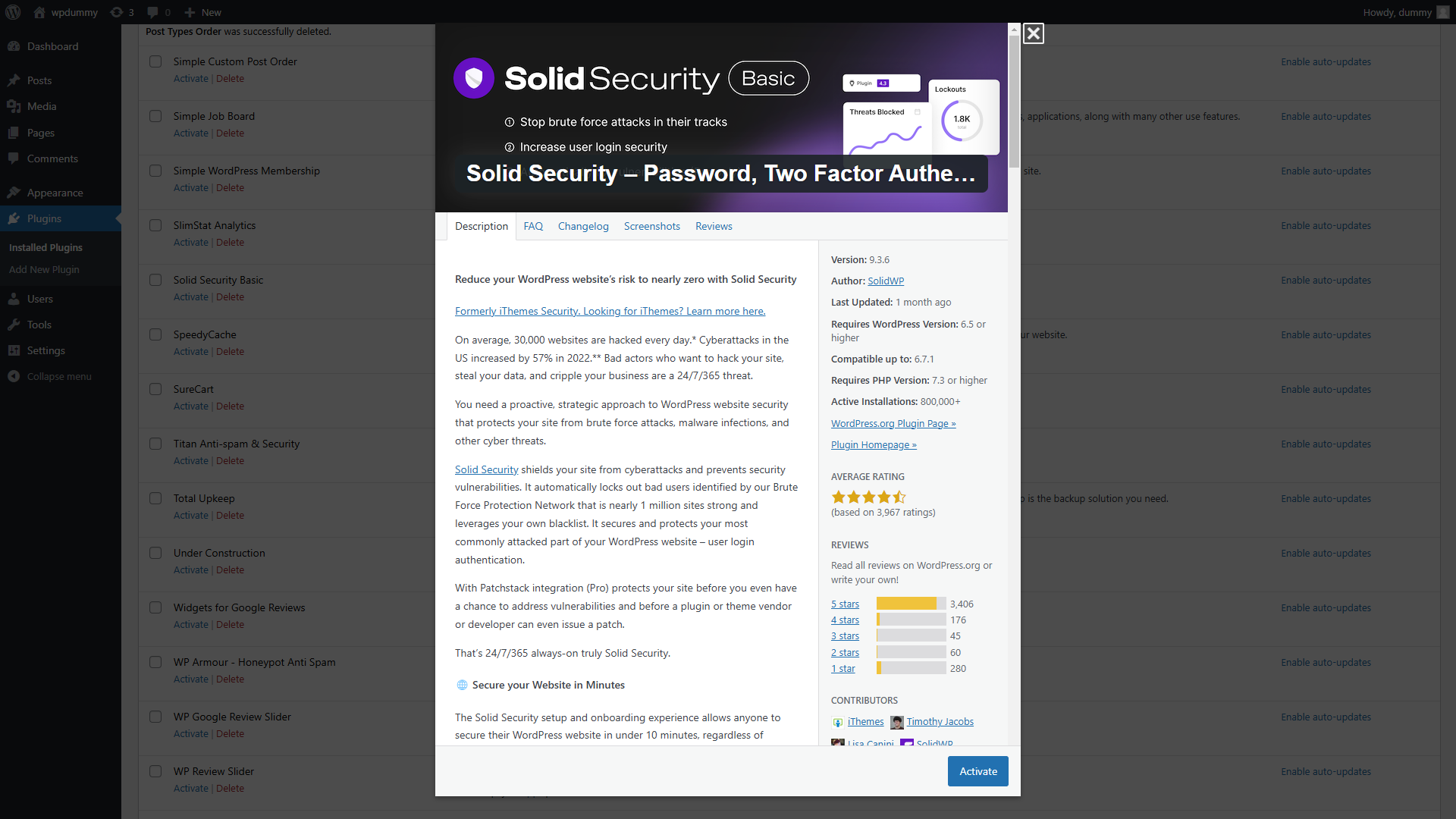Solid Security in WordPress: Passwords, Two-Factor Authentication, and Brute Force Protection
WordPress is the most widely used content management system (CMS) globally, powering over 40% of all websites. While its popularity stems from its ease of use and vast plugin ecosystem, it is also a prime target for cyberattacks. Solid security measures, particularly in areas such as password management, two-factor authentication (2FA), and brute force protection, are critical to safeguarding WordPress websites.
Thankfully, a variety of WordPress plugins make implementing these security measures easy and effective. In this article, we will delve into the importance of these security practices, the role of plugins, and the top options for enhancing your site’s security.

Importance of Strong Password Management
Passwords serve as the first line of defense against unauthorized access to your WordPress site. Weak or reused passwords are a significant vulnerability, and a breach could lead to catastrophic consequences, such as website defacement, data theft, or malware injection. Despite their importance, many users continue to rely on simple or easily guessed passwords.
How WordPress Plugins Help with Password Security
WordPress plugins offer advanced password management features that enforce best practices, such as:
- Password Strength Enforcement: Ensuring users create strong, unique passwords.
- Password Expiration: Requiring users to update their passwords periodically.
- Login Attempts Monitoring: Tracking login attempts and blocking suspicious activity.
- Admin Notifications: Alerting administrators when passwords are changed.
Two-Factor Authentication (2FA)
Two-factor authentication (2FA) adds an additional layer of security by requiring users to provide two forms of verification to access their accounts. Typically, this involves something the user knows (password) and something they have (a code sent to their phone or email). This extra step significantly reduces the risk of unauthorized access, even if passwords are compromised.
How 2FA Enhances WordPress Security
With 2FA, even if a malicious actor manages to acquire a password, they cannot access the account without the second authentication factor. WordPress plugins that implement 2FA provide a variety of options, such as:
- Time-Based One-Time Passwords (TOTP): Codes generated via apps like Google Authenticator or Authy.
- SMS Authentication: Sending verification codes via text messages.
- Email-Based Codes: Sending a temporary passcode to the user’s email.
- Hardware Tokens: Devices like YubiKey for hardware-based authentication.
Brute Force Protection
A brute force attack occurs when an attacker systematically tries various username and password combinations until they find a match. Since WordPress does not limit login attempts by default, brute force attacks are a common and persistent threat.
The Role of Brute Force Protection Plugins
Brute force protection plugins shield WordPress sites by:
- Limiting Login Attempts: Blocking IP addresses after a specified number of failed attempts.
- Login Captcha: Adding CAPTCHAs to the login page to differentiate between humans and bots.
- Geolocation Blocking: Restricting access from specific countries or regions.
- IP Blacklisting and Whitelisting: Allowing trusted IPs while blocking suspicious ones.
Top WordPress Plugins for Solid Security
Several WordPress plugins specialize in password management, 2FA, and brute force protection. Below are some of the best options for enhancing your site’s security:
1. Wordfence Security
Wordfence is a comprehensive WordPress security plugin that offers robust features for protecting your site.
- Password Management: Enforces strong passwords for all users.
- 2FA: Provides TOTP-based two-factor authentication.
- Brute Force Protection: Limits login attempts, blocks suspicious IPs, and tracks failed login attempts in real-time.
With over 4 million active installations, Wordfence is one of the most trusted plugins for securing WordPress sites.
2. iThemes Security
iThemes Security focuses on preventing common security vulnerabilities in WordPress.
- Password Management: Enforces password strength policies and tracks password changes.
- 2FA: Offers TOTP-based 2FA, compatible with apps like Google Authenticator.
- Brute Force Protection: Automatically blocks IPs that attempt repeated failed logins and provides detailed logging of all login activity.
The plugin also includes a “Security Check Pro” feature for one-click configuration of recommended settings.
3. Sucuri Security
Sucuri Security is known for its robust protection against malware and hacking attempts.
- Password Management: Alerts administrators about weak passwords and allows forced password resets.
- 2FA: Includes a flexible two-factor authentication module.
- Brute Force Protection: Blocks IPs that exhibit suspicious login behavior and integrates with firewalls for enhanced security.
Sucuri also provides additional features, such as file integrity monitoring and malware scanning.
4. Loginizer
Loginizer is a lightweight plugin specifically designed to protect against brute force attacks.
- Password Management: Focuses on securing login pages with CAPTCHA and strong password policies.
- 2FA: Offers optional two-factor authentication.
- Brute Force Protection: Limits login attempts and includes geolocation-based blocking.
The simplicity and efficiency of Loginizer make it ideal for smaller sites.
5. Shield Security
Shield Security is a user-friendly plugin with a focus on automation and minimal configuration.
- Password Management: Enforces strong passwords and password expiration policies.
- 2FA: Includes options for TOTP, email-based codes, and hardware tokens.
- Brute Force Protection: Blocks malicious IPs, restricts login attempts, and adds CAPTCHAs to the login form.
The plugin’s detailed reporting feature helps administrators monitor and respond to security incidents effectively.
Best Practices for Using Security Plugins
To maximize the benefits of these plugins, follow these best practices:
- Keep Plugins Updated: Regularly update security plugins to benefit from the latest patches and features.
- Monitor Logs: Review login and activity logs to detect suspicious behavior early.
- Avoid Plugin Overlap: Use one comprehensive security plugin rather than multiple overlapping ones to prevent conflicts.
- Educate Users: Train site administrators and users on the importance of strong passwords and safe login practices.
- Backup Regularly: Implement a robust backup solution to ensure your site can be restored quickly in the event of an attack.
Conclusion
Password management, two-factor authentication, and brute force protection are essential components of a solid WordPress security strategy. With the right plugins, implementing these measures is straightforward and effective. WordPress plugins like Wordfence, iThemes Security, Sucuri, Loginizer, and Shield Security provide powerful tools to safeguard your site against unauthorized access and malicious attacks.
By prioritizing these security measures and leveraging reliable plugins, you can significantly reduce the risk of a security breach and ensure your WordPress site remains safe and secure. Always remember that a proactive approach to security is the best defense against evolving threats in the digital landscape.





